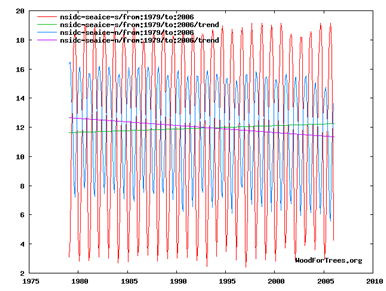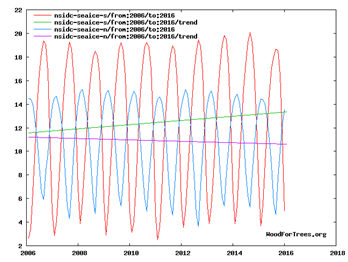New NASA Survey Finds Antarctica Covered in More Ice Than Previously Thought
http://www.thegwpf.com/new-survey-finds-antartica-covered-in-more-ice-than-previously-thought/
NEW NASA SURVEY FINDS ANTARCTICA COVERED IN MORE ICE THAN PREVIOUSLY THOUGHT
Date: 14/08/16
Trevor English, Interesting Engineering
Antartica is one of the most ice-covered locations in the world, but it is also one of the world’s largest land masses. Previous estimates by researchers placed the level of uncovered land in Antartica at about 1%. However, a new survey in part by NASA shows that this estimate was rather generous and the continent is covered in a lot more ice than previously thought. Researchers from Cryosphere have shown that only.18 percent of the entire continent is not covered by ice and snow, which is surprisingly low. With this new figure, researchers will monitor this survey over time to see the effects of climate change and global warming.

[Image Source: NASA]
“With effects ranging from influencing ocean currents to raising sea level, Antarctica plays a large role in the global climate system. Researchers are using a variety of methods to understand how Antarctica will react to a changing climate, but limited information on ice thickness and what lies beneath the ice makes this work challenging.” ~ NASA
This new research has been put off for a while, and it may surprise you that this is the first time we have had an accurate representation of Antartica’s land mass. Automated techniques were used in the new study to allow seamless data collection as well as the automatic removal of clouds over the continent to make the snow and ice readings more accurate. The NASA and US Geological Survey satellite was used for the new study, which corrected previous ice and snow calculations in comparison to land mass.
Full post
…West Antarctic Glaciers Have Been Retreating For Last 7500 Years
West Antarctic Glaciers Have Been Retreating For Last 7500 Years
By Paul Homewood http://www.sciencemag.org/news/1999/10/antarctic-ice-beats-retreat Climate scientists, with their new toys, would like you to believe that glacier retreat in West Antarctica is a recent phenomenon, caused by man. Back in 1999 however, scientists revealed that these glaciers have actually been retreating at a fairly steady rate for at the last 7500 years: An icy crust covering part of Antarctica has receded steadily for the last 20,000 years and may continue to do so regardless of human impacts on climate, a new study suggests. At its current rate of retreat, the ice will disappear in 7000 years, researchers report in tomorrow’s Science. However, the team cannot rule out a sudden collapse of the ice sheet in the next few centuries–an event that would raise sea levels worldwide by 5 or 6 meters. The West Antarctic Ice Sheet is a mass of thick glaciers spanning nearly a million square kilometers. It rests on bedrock that sits below sea level. Contact with the gradually rising ocean may make the sheet more unstable than ice at higher elevations elsewhere on Antarctica. Indeed, when glaciologists drilled through the ice sheet, they found signs that it has disintegrated completely sometime within the last 1.3 million years, in a climate not much warmer than today’s (Science, 3 July 1998, p. 17). However, researchers had few details about the timing and extent of melting during recent millennia. The new study pins down several dates and locations that trace the ice sheet’s shrinkage. The team–led by glaciologist Howard Conway of the University of Washington in Seattle and geologist Brenda Hall of the University of Maine, Orono–used radar to image old layers within the ice, which revealed its growth and decay over time. The researchers also used radiocarbon dating to analyze the ages of organic material left high and dry on beaches as the ice sheet melted away to expose land, which rises as the weight is lifted during the ice’s retreat. These and other methods revealed a pattern of steady retreat at an average rate of 120 meters per year over the last 7500 years. “We suspect this is an ongoing and long-term natural cycle triggered by rising sea levels at the end of the last ice age,” says Conway. The relentless melting would continue even without human-induced climate changes, he believes. “This is top-notch work,” says glaciologist …
Backflip: Antarctic peninsula, posterchild of Polar disaster, has been cooling not warming
…University of Deleware Penguin Panic Paper Exposed As Flawed… Used ‘Tricks’
Antarctic climate models fail to handle natural variability: Adélie penguins continue to appear
By Dr. Sebastian Lüning and Prof. Fritz Vahrenholt
(German text translated/edited by P. Gosselin)
On June 29, 2016 the University of Delaware (UD) unleashed a climate penguin panic with its press release:
Penguins and climate change:
UD scientists report projected response of Adélie penguins to Antarctic climate change
It’s a big question: how is climate change in Antarctica affecting Adélie penguins? Climate has influenced the distribution patterns of Adélie penguins across Antarctica for millions of years. The geologic record tells us that as glaciers expanded and covered Adélie breeding habitats with ice, penguin colonies were abandoned. When the glaciers melted during warming periods, this warming positively affected the Adélie penguins, allowing them to return to their rocky breeding grounds. But now, University of Delaware scientists and colleagues report that this beneficial warming may have reached its tipping point. In a paper published today in Scientific Reports, the researchers project that approximately 30 percent of current Adélie colonies may be in decline by 2060 and approximately 60 percent may be in decline by 2099.”
That’s absolutely bitter. More than half of the penguins will be dead by 2099. In earlier times they benefitted from climate warming, but today heat is threatening to wipe them out. How has this come to be? The press release continues:
It is only in recent decades that we know Adélie penguins population declines are associated with warming, which suggests that many regions of Antarctica have warmed too much and that further warming is no longer positive for the species,” said the paper’s lead author Megan Cimino, who earned her doctoral degree at UD in May.”
Antarctica has warmed unusually over the past decades?
Unfortunately that is completely wrong, see here. Precisely on this subject a new paper by Jones et al. 2016 in Nature Climate Change tells us:
Assessing recent trends in high-latitude Southern Hemisphere surface climate
Understanding the causes of recent climatic trends and variability in the high-latitude Southern Hemisphere is hampered by a short instrumental record. Here, we analyse recent atmosphere, surface ocean and sea-ice observations in this region and assess their trends in the context of palaeoclimate records and climate model simulations. Over the 36-year satellite era, significant linear trends in annual mean sea-ice extent, surface temperature and
Antarctic Peninsula Has Been Cooling For Almost 20 Years, Scientists Confirm
http://www.thegwpf.com/antarctic-has-been-cooling-for-almost-20-years-scientists-confirm/
One of the big climate lies is that the Antarctic Peninsula is one of the fastest warming places on Earth. (The key word here is “IS”)…
Consensus? Orthodox Climate Science Performs A Major Flip-Flop On Antarctica
…Shrinking Ozone Hole Leads To Cooling Antarctic Temperatures
…Updated NASA Data Shows That Global Warming/Climate Change Not Causing Recession Of Polar Ice
Updated NASA data on the polar ice cap is showing results that are contrary to all who claim global warming is receding it. Reportedly, global warming (better known presently as climate change) has not caused any recession of polar ice.
According to a report by Forbes, a NASA satellite instrument revealed that the Earth’s polar ice caps have not receded at all since it began its measurements back in 1979. From what was shown in its data, total polar ice has generally remained above the post-1979 average, a finding that contradicts the most-frequently spoken claims by those who push global warming as the primary reason why the polar ice caps are receding.…
Amazing Climate UNCHANGE …Global Sea Ice Over Past 38 Years Remains Virtually Level
By Kenneth Richard
Everyone knows that climate change is normal occurs naturally, at times rapidly, and that there is really nothing we can do about it. Amazingly, with some climate aspects, there has not been any change in about 40 years.
According to NSIDC sea ice trend data, from 1979 to 2006, the sea ice losses for the Arctic (purple trend line in graph below) were effectively counterbalanced by the sea ice gains in the Antarctic (green trend line), producing a conspicuously flat trend line in global sea ice.
Global sea ice has remained unchanged over the past 38 years, as measured by satellite. Source: woodfortrees.com here.
From 2006 to 2016, global sea ice trends have also been remarkably stable despite a massive increase in anthropogenic CO2 emissions during this period. In fact, the sea ice gains in Antarctica have perhaps modestly superseded the losses in the Arctic, resulting in a very slight increasing overall trend in global-scale sea ice during the last 10 years:
Overall trend surprisingly shows slight increase. Source. woodfortrees.com here.
In 1979, global atmospheric CO2 was measured at 337 ppm. In 2016, global atmospheric CO2 has exceeded 400 ppm.
For both hemispheres combined, then, the addition of about 65 ppm of atmospheric CO2 concentration since 1979 has apparently had no overall effect on global-scale sea ice trends.
– See more at: http://notrickszone.com/2016/07/04/amazing-climate-unchange-global-sea-ice-over-past-38-years-remains-virtually-level/#sthash.6tp7y5Mj.dpuf…
Study: Expanding Antarctic sea ice linked to – – Natural Variability!
Expanding Antarctic sea ice linked to Natural Variability!!
http://sunshinehours.net/2016/07/04/expanding-antarctic-sea-ice-linked-to-natural-variability
Oh sure. If the climate does something that doesn’t match the theory they blame “natural variability”. But maybe … just maybe … climate is mostly natural variability. The recent trend of increasing Antarctic sea ice extent—seemingly at odds with climate model projections—can largely be explained by a natural climate fluctuation, according to a new study led by the National Center for Atmospheric Research (NCAR). The study offers evidence that the negative phase of the Interdecadal Pacific Oscillation (IPO), which is characterized by cooler-than-average sea surface temperatures in the tropical eastern Pacific, has created favorable conditions for additional Antarctic sea ice growth since 2000. The findings, published in the journal Nature Geoscience, may resolve a longstanding mystery: Why is Antarctic sea ice expanding when climate change is causing the world to warm? Read more at: http://phys.org/news/2016-07-antarctic-sea-ice-linked-natural.html#jCp
— gReader Pro…



